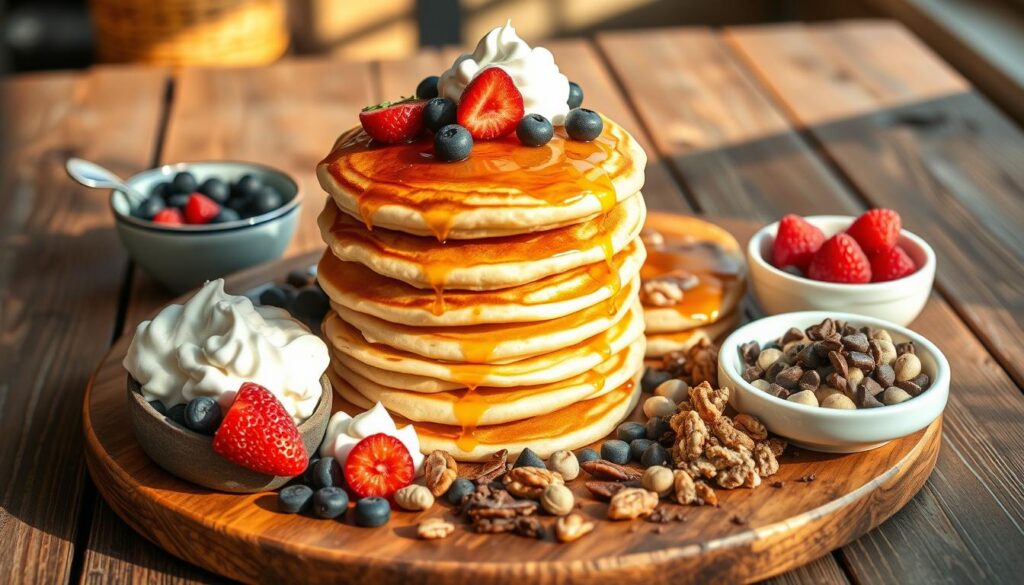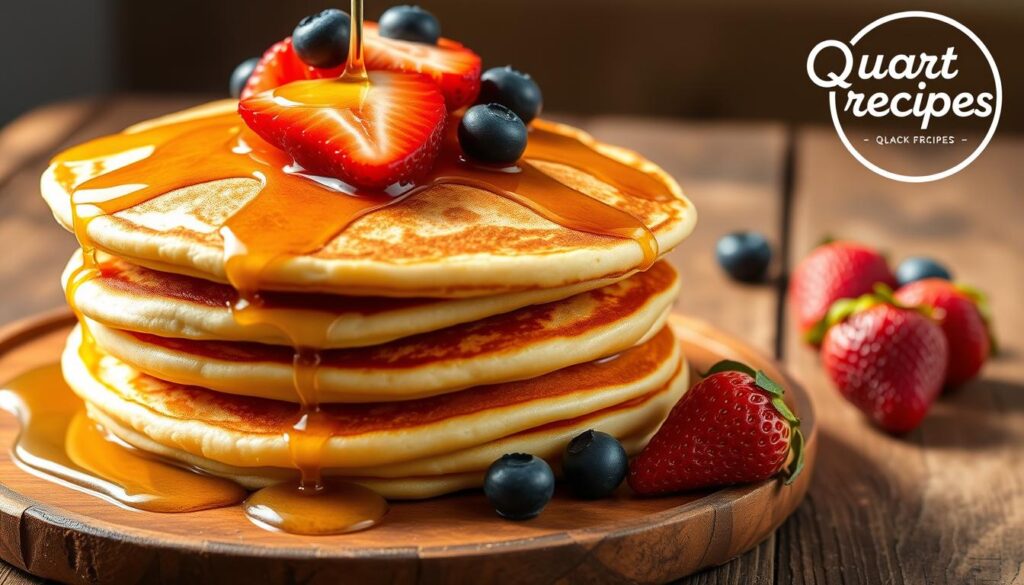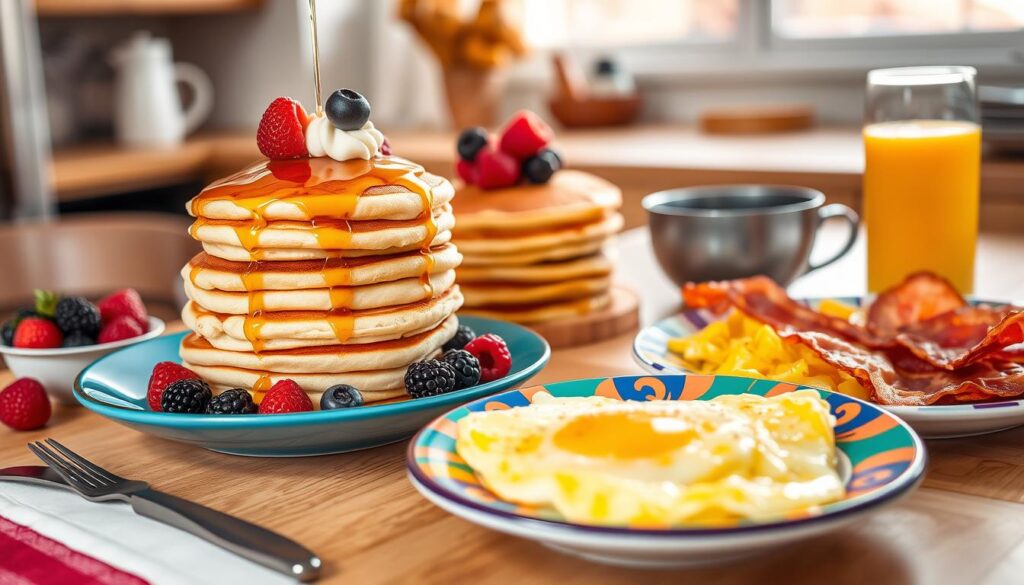Breakfast is key, and pancakes are a favorite for many. Understanding pancakes calories is essential for maintaining a healthy diet. This guide will help you learn about pancakes calories and make smart breakfast choices.
Key Takeaways:pancakes calories
- Learn about pancake nutrition, including macronutrients and serving sizes.
- Find out how many calories are in different pancakes, like buttermilk and whole wheat.
- See how toppings can change your pancake’s calorie count.
- Get tips for healthier pancakes, like using different ingredients and controlling portions.
- Know the nutrition differences between restaurant and homemade pancakes. Learn how to eat them healthily.
Understanding Pancake Nutrition Basics:pancakes calories
Pancakes are a favorite breakfast food. But have you thought about their nutrition? Looking at pancake ingredients can help us understand their place in a healthy diet.
Essential Nutritional Components
Pancakes are made from pancake ingredients like flour, eggs, milk, and baking powder. These ingredients add carbohydrates, proteins, and fats to pancakes. Each one is important for our health.
Macronutrient Breakdown:pancakes calories
A pancake is mostly carbohydrates, giving us energy. But eggs and milk add protein and fat. This makes pancakes a more complete food.
Serving Size Guidelines:pancakes calories
It’s important to control how much pancake you eat. A good serving size is 1/4 cup of batter. This makes 1-2 small pancakes. Eating the right amount helps pancakes fit into a healthy diet.
Pancakes Calories: Breaking Down the Numbers
Pancakes can have different calorie counts. This depends on the type and size. Knowing the pancake varieties helps you choose a healthy breakfast.
A classic buttermilk pancake serving has 200-300 calories. Three whole wheat pancakes have 300-400 calories. The calorie count changes with ingredients like flour, sugar, and toppings.
The energy density of pancakes affects calories too. Recipes with more fat, like butter, have more calories. But, pancakes with low-fat milk or fruit are healthier and lower in calories.
Knowing about calorie content and energy density helps you pick better pancakes. This way, you can enjoy pancakes while staying healthy.
Health Impact of Different Pancake Types
Not all pancakes are the same. Knowing the health benefits of buttermilk, whole wheat, and protein pancakes helps you choose wisely. This choice can match your diet and health goals.
Classic Buttermilk Pancakes:pancakes calories
Buttermilk pancakes are a favorite for breakfast. They mix dietary fiber and carbs well. But, they have more calories and less protein than other pancakes. This makes them less good for a balanced meal.
Whole Wheat Alternatives:pancakes calories
Whole wheat pancakes are a better choice. They have more dietary fiber and are better than white flour pancakes. They help with digestion and keep you full longer.
Protein-Enhanced Options
Protein pancakes are great for a protein-rich breakfast. They have whey, egg, or plant-based protein. This helps with muscle and weight goals.
Common Toppings and Their Caloric Impact
Choosing toppings for pancakes can change how many calories you eat. Syrup and butter are tasty but have lots of calories. Even fruit toppings can add calories because of their sugars.

Think about how your toppings affect your calorie count. A tablespoon of maple syrup has 52 calories. A small piece of butter adds 36 calories. Fruits like blueberries or strawberries are sweet but can also increase calories.
Knowing how many calories your toppings have helps you make better choices. This way, you can enjoy pancakes without worrying about your health.
Making Healthier Pancake Choices
Enjoying tasty pancakes and staying healthy is possible. Learn how to make healthier pancakes without losing flavor.
Low-Calorie Ingredient Substitutions
Lowering pancake calories is easy. *Use skim or plant-based milk instead of full-fat milk.* Replace butter or oil with Greek yogurt or applesauce. These changes cut calories without losing taste or texture.
Portion Control Strategies
Controlling portions is key for a balanced diet. *Eat the right amount by using smaller plates.* Add fresh fruit or Greek yogurt to make your meal better.
Cooking Methods That Matter
How you cook pancakes affects their calories. *Choose non-stick skillets and use little oil or butter.* Try baking or griddling for a healthier option.
With these tips, you can enjoy healthy pancakes. Try different ingredients, control portions, and use smart cooking methods. This way, pancakes can be a nutritious breakfast choice.
Restaurant vs. Homemade Pancake Nutrition
When you dine out or make homemade pancakes, the nutrition is different. Restaurant pancakes have more calories because they are bigger and made with richer ingredients. Making pancakes at home lets you choose healthier ingredients.

A restaurant pancake can have 400-500 calories. But, a homemade pancake with whole wheat flour and low-fat milk has 200-300 calories. This big difference matters when you choose where to eat.
Restaurant pancakes also have more sugars, fats, and sodium than homemade ones. Making pancakes at home lets you pick better ingredients. You can make them just right for your diet.
Balancing Pancakes in a Healthy Diet:pancakes calories
Pancakes can be a fun breakfast choice. But, we must think about how they fit into a healthy diet. By using smart meal planning tips and knowing about nutritional timing, you can have pancakes as part of a balanced breakfast. This way, you won’t hurt your dietary planning.
Meal Planning Tips
To add pancakes to your diet, focus on meal composition. Make sure your meals have lots of foods that are good for you. Include fruits, veggies, lean proteins, and whole grains. This way, pancakes won’t be the only thing on your plate. They’ll add to a balanced breakfast full of important nutrients.
Nutritional Timing:pancakes calories
When you eat pancakes matters too. Try to have them for breakfast or brunch. This is when your body is ready to use the nutrient timing and energy they give. It helps with your dietary planning and keeps you healthy.
Special Dietary Considerations:pancakes calories
For those with special diets, finding pancakes can be hard. But, with some creativity and the right swaps, gluten-free pancakes, vegan options, low-carb alternatives, and allergen-free recipes are possible. They can be part of a healthy breakfast.
People with gluten issues can enjoy gluten-free pancakes. They use flours like almond, coconut, or gluten-free blends. These pancakes taste and feel like regular ones, but without gluten.
Vegan eaters can make tasty vegan pancakes. They use plant milk and egg substitutes like flax or chia seeds. These choices are good for those who don’t eat dairy or eggs.
For a low-carb diet, try low-carb alternatives. Use almond flour, coconut flour, or even cauliflower. These options are full of nutrients and keep carbs low.
Weight Management and Pancake Consumption:
Pancakes can be part of a healthy diet if you eat them wisely. It’s key to enjoy pancakes while keeping an eye on your weight loss or calorie management. You can do this by eating mindfully and saving pancakes for special times.
Smart Portion Control:pancakes calories
Controlling how much you eat is a smart way to enjoy pancakes. Don’t eat too much. Stick to the right sizes. This way, you can enjoy the taste without too many calories.
Balancing Indulgence with Health:
It’s important to balance enjoying pancakes with eating healthy. Make pancakes a special treat, not something you eat every day. This way, you can enjoy them without hurting your health and wellness.
Best Time to Enjoy Pancakes:pancakes calories
Timing is key when it comes to pancakes. They can boost your health and fitness if eaten at the right time.
Pancakes are great pre-workout fuel. They give you energy with carbs and a bit of protein. Just eat the right amount to stay energized.
After working out, pancakes help with recovery. They have carbs and protein to fix muscles and refill energy. Choose whole-grain or protein pancakes for more benefits.
Pancakes are also good for breakfast. They give you energy and nutrients to start your day right. They keep your energy up all morning.
When to eat pancakes depends on you. They can fit into your diet and help your health if you plan it right.
Conclusion
Understanding pancake calories is key. It’s all about balance. You can enjoy pancakes in a healthy way.
Know the nutritional facts. Choose wisely. And don’t overdo it.
Try different types of pancakes. But watch your portions. This way, you can enjoy them without feeling guilty.
Remember, it’s all about balance. Enjoy your pancakes but also think about your health.
So, go ahead and have pancakes. But do it in a way that’s good for you.
Enjoy every bite. Let pancakes be a fun part of your healthy diet.

